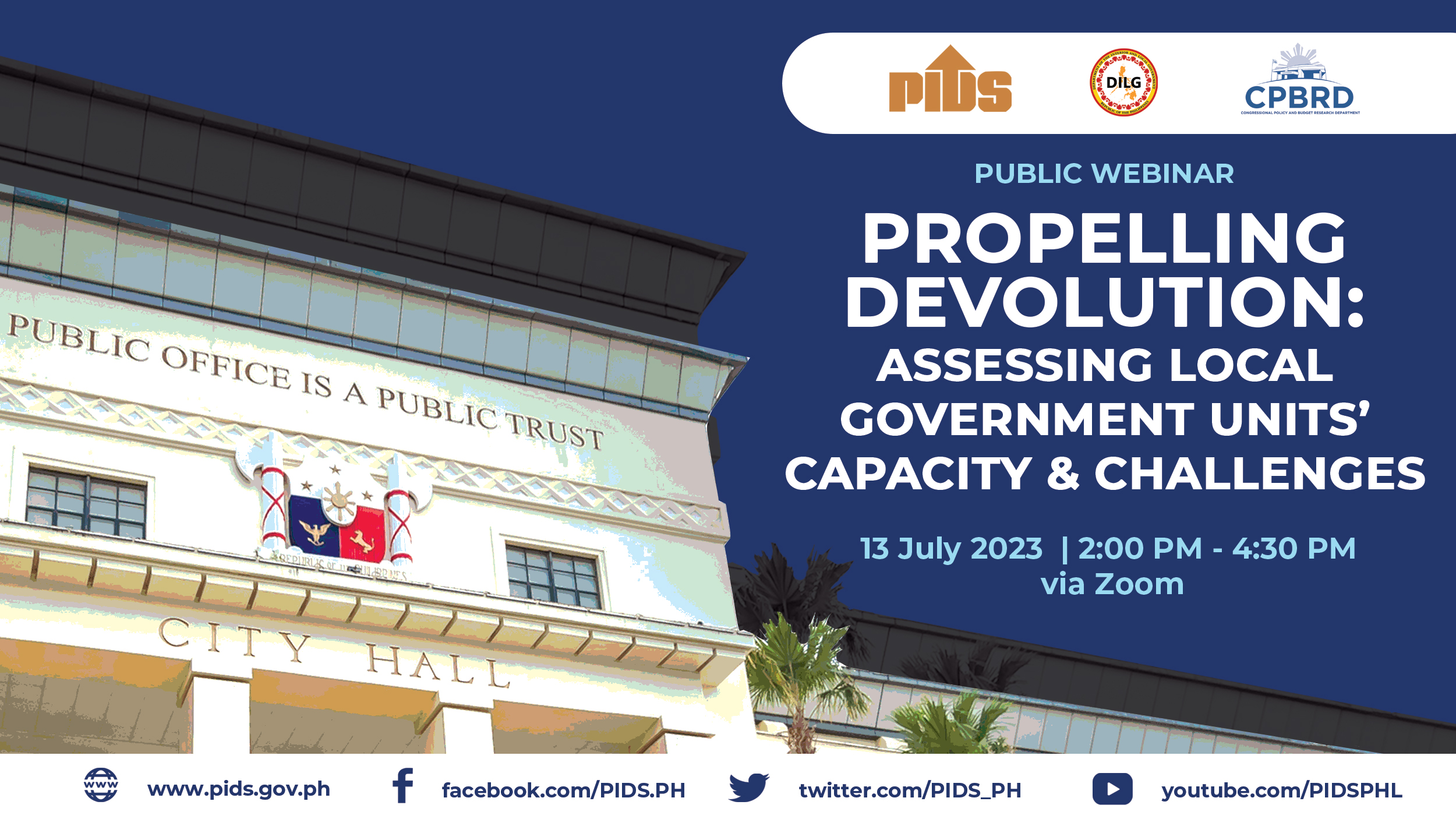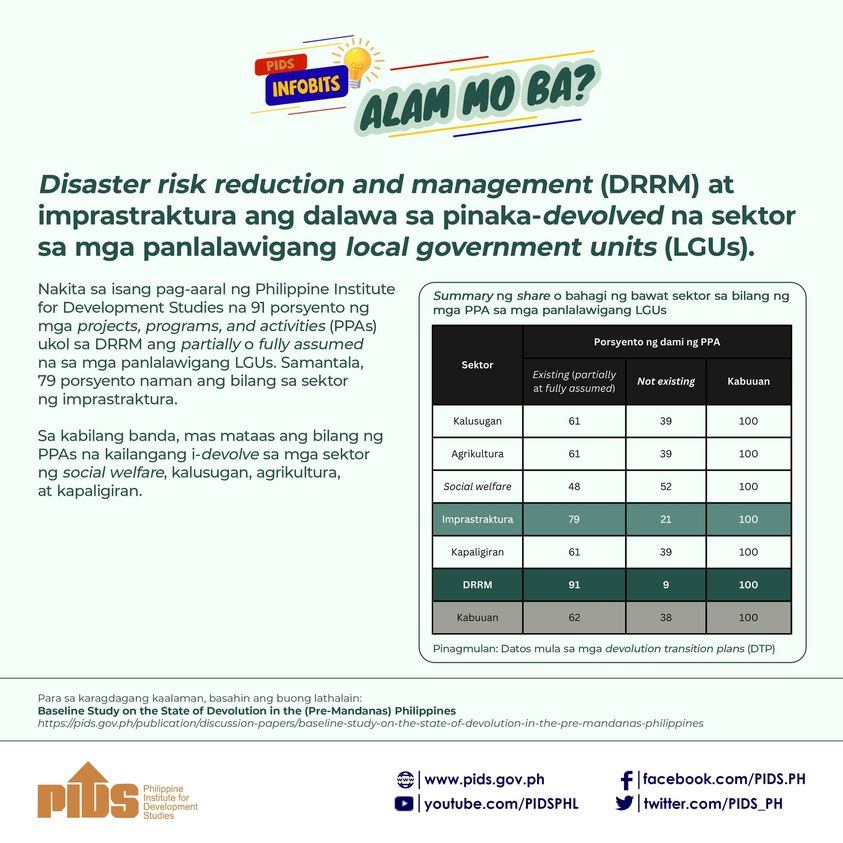The government’s total infrastructure funding for health facilities reached P16.9 billion between 2010 and 2014, according to a study released by the Philippine Institute for Development Studies (PIDS).
In a study, titled “The Impact of Improving Capital Stock on the Utilization of Local Health Services: Preliminary Findings on the Evaluation of the HFEP,” PIDS senior research fellow Oscar F. Picazo said that this translated to an annual investment of only P3.4 billion during the period.
The funding was extended through the Health Facilities Enhancement Program (HFEP), which sought to provide infrastructure and medical equipment to government health facilities.
“The average funding per health facility is small: P9.8 million per hospital/infirmary and P1.8 million per RHU [Regional Health Unit]/CHO [City Health Office],” the study stated.
However, data showed that despite the “small” average funding received by RHUs and CHOs, the study found that hospitals with HFEP, on a monthly basis, catered to an average of 98 expectant mothers, which is three times more than the 32 deliveries in hospitals without HFEP.
For outpatient consultations, hospitals with HFEP had an average of 70 patients, or 2.3 times more than in those without HFEP, which had an average of 30 patients.
For inpatient admissions, HFEP-supported hospitals had an average of 47 inpatient admissions per day, nearly double, or 1.8 times, the 26 average inpatient admissions in those that did not receive HFEP.
In terms of before and after scenarios of the HFEP, data showed not all HFEP recipients were able to increase their health services.
For outpatient consultations, around 75 percent of the RHUs, or 45 out of 60, with complete data showed increased outpatient consultations.
Further, some 65 percent of hospitals, or 39 out of 57, with complete data showed increased outpatient consultations.
For birth deliveries, some 49 percent of RHUs and CHOs, or 29 out of 55, with complete data showed increased birth deliveries.
Around 75 percent of hospitals and infirmaries, or 46 out of 61, with complete data showed increased birth deliveries.
For inpatient services, some 81 percent of hospitals and infirmaries, or 47 out of 58, with complete data showed increased inpatient admissions per day.
“The impact of capital investments is often diluted by staff shortage and dramatic contractualization of health workers, as well as persistent [medication] drug shortage,” the study stated.
The study recommended the conduct of additional studies on hospital occupancy of local government units and the efficiency of local hospitals using data from the HFEP survey.
Further study is also recommended to examine the contractualization of health workers and the adequacy and workload of health workers in RHUs/CHOs.
Other studies must also be undertaken on the PhilHealth coverage of local health units; the practice of no-balance billing and point of care enrollment; and health financing innovations used by health facilities.
The study included data from 266 RHUs/CHOs (159) and hospitals and infirmaries (107) located provinces nationwide.
Around 26 provinces were included in the study. This included 11 provinces in Luzon; eighth in Mindanao; and seven in the Visayas.//
In a study, titled “The Impact of Improving Capital Stock on the Utilization of Local Health Services: Preliminary Findings on the Evaluation of the HFEP,” PIDS senior research fellow Oscar F. Picazo said that this translated to an annual investment of only P3.4 billion during the period.
The funding was extended through the Health Facilities Enhancement Program (HFEP), which sought to provide infrastructure and medical equipment to government health facilities.
“The average funding per health facility is small: P9.8 million per hospital/infirmary and P1.8 million per RHU [Regional Health Unit]/CHO [City Health Office],” the study stated.
However, data showed that despite the “small” average funding received by RHUs and CHOs, the study found that hospitals with HFEP, on a monthly basis, catered to an average of 98 expectant mothers, which is three times more than the 32 deliveries in hospitals without HFEP.
For outpatient consultations, hospitals with HFEP had an average of 70 patients, or 2.3 times more than in those without HFEP, which had an average of 30 patients.
For inpatient admissions, HFEP-supported hospitals had an average of 47 inpatient admissions per day, nearly double, or 1.8 times, the 26 average inpatient admissions in those that did not receive HFEP.
In terms of before and after scenarios of the HFEP, data showed not all HFEP recipients were able to increase their health services.
For outpatient consultations, around 75 percent of the RHUs, or 45 out of 60, with complete data showed increased outpatient consultations.
Further, some 65 percent of hospitals, or 39 out of 57, with complete data showed increased outpatient consultations.
For birth deliveries, some 49 percent of RHUs and CHOs, or 29 out of 55, with complete data showed increased birth deliveries.
Around 75 percent of hospitals and infirmaries, or 46 out of 61, with complete data showed increased birth deliveries.
For inpatient services, some 81 percent of hospitals and infirmaries, or 47 out of 58, with complete data showed increased inpatient admissions per day.
“The impact of capital investments is often diluted by staff shortage and dramatic contractualization of health workers, as well as persistent [medication] drug shortage,” the study stated.
The study recommended the conduct of additional studies on hospital occupancy of local government units and the efficiency of local hospitals using data from the HFEP survey.
Further study is also recommended to examine the contractualization of health workers and the adequacy and workload of health workers in RHUs/CHOs.
Other studies must also be undertaken on the PhilHealth coverage of local health units; the practice of no-balance billing and point of care enrollment; and health financing innovations used by health facilities.
The study included data from 266 RHUs/CHOs (159) and hospitals and infirmaries (107) located provinces nationwide.
Around 26 provinces were included in the study. This included 11 provinces in Luzon; eighth in Mindanao; and seven in the Visayas.//












